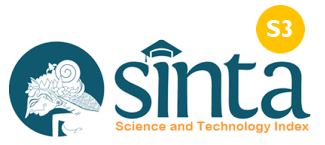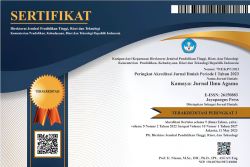Hadis-Hadis Wabah Taun dalam Fatwa Mui Nomor 14 Tahun 2020
(Studi Ma’ani Al-Hadits)
DOI:
https://doi.org/10.37329/kamaya.v6i4.2799Keywords:
Hadith, MUI Fatwa, Taun PlagueAbstract
MUI Fatwa Number 14 of 2020 regarding the epidemic this year there are still many pros and cons among the public. The public doubted and rejected the fatwa. The reason is because people doubt the accuracy of the arguments used, especially the hadiths contained in them. This research aims to understand the meaning of hadiths about the year's epidemic and their relevance to the COVID-19 outbreak. The research uses library research using data collection techniques using takhrij al-hadith, i'tibar al-sanad, naqd al-matan, and fiqh al-hadith. After the data was collected, data analysis was carried out using an inductive method which refers to three procedures, namely analysis of the matan test, providing conclusions on the status of the validity of the hadith and analysis of the understanding of the hadith. This research found that the hadith contained in MUI fatwa Number 14 of 2020 can be used as hujjah (maqbul). The meaning of these hadiths is relevant to preventing the COVID-19 outbreak which then has preventive steps in dealing with the outbreak. The Prophet's recommendation to carry out quarantine for those infected with the plague, means that there is separation between infected people and healthy people. The values of handling this year's outbreak can be applied in Indonesia based on Law No. 6 of 2018 concerning Health Quarantine.
References
Fariana, Andi. (2017). Urgensi Fatwa MUI dalam Pembangunan Sistem Hukum Ekonomi Islam di Indonesia. AlIhkam, Jurnal Hukum dan Pranata Sosial. Vol.12. No.1.
Fauzi. (2021). Implementasi PSBB Sebuah Kebijakan Publik Dalam Penangaanan COVID-19. Jurnal Widaiydaya Ahli Madya, 14 (1).
Griffhits. The Fear of COVID-19 and its Role in Preventive Behaviors. Journal of Concurrent Disorders, 2 (1). 2020.
Hairi. (2020). Implikasi Hukum PSBB Terkait Pencegahan COVID-19. Jurnal Info, 14 (4).
Hamzah, Muhammad. (2017). Peran dan Pengaruh Fatwa MUI dalam Arus Transformasi Sosial Budaya di Indonesia. Vol. XVII, no. 1 (2017), pp. 127-154
Imamuddin, M. Firdaus. (2021). Studi Persepsi Masyarakat Terhadap Fatwa MUI no 14 Tahun 2020 Tentang Penyelenggaraan Ibadah Dalam Situasi Terjadi Wabah Covid-19, JISA: Jurnal Ilmiah Sosiologi Agama, Vol. 03 No. 02, 2021.
Ilyas. (2020). Dampak dan Pencegahan Wabah Covid-19 Perspektif Sains dan Islam. Jurnal Perspektif UIN SGD Bandung, 1 (2).
Mardiana, Dede. (2021). Rasulullah Saw dan Pencegahan Wabah Covid-19; Studi Tematik Hadis-hadis Penyakit Menular, Jurnal Penelitian Ilmu Ushuluddin, Vol 01 No. 03 Tahun 2021.
Mustaqim, Abdul. (2016). Ilmu Ma’anil Hadis Paradigma Interkoneksi. Yogyakarta: Idea Press Yogyakarta.
Mutakabbir, Abdul & Said, Rukman, A. (2021). Dinamisasi Hukum Islam, Analisis Fatwa MUI Masa Pandemi Covid 19. Palita: Journal of Social Religion Research Oktober-2021, Vol.6, No.2, hal.171-190
Nafi'ah, Zaenab Nur. (2021). Analisis Fatwa MUI Tentang Pelaksanaan Ibadah di Masjid Selama Pandemi (Fatwa MUI no 14 tahun 2020 Tentang Penyelenggaraan Ibadah Dalam Situasi Terjadi Wabah Covid-19), HIKMATINA: Jurnal Ilmiah Hukum Keluarga Islam, Vol. 03 No. 02.
Rahmah. (2020). Edukasi Kesehatan untuk Isolasi Mandiri dalam Upaya Penanganan Covid-19. Jurnal Abidas, 2 (1).
Rahman, Fatchur. (2000). Ikhtisar Mushthalahul Hadits, Bandung: PT Alma’arif.
Saeful, Achmad. (2021). Menelaah Kembali Fatwa MUI Tentang Penyelenggaraan Ibadah Dalam Situasi Terjadi Wabah Covid-19, Jurnal SYAR’IE Vol. 03 No. 02, Agustus 2021.
Saenong, Faried F.., Cucu Nurhayati, Rosita Tandos, Naif Abdan, Syahrullah Iskandar, Amiruddin Kuba, Zainal Abidin, A. Muid Nawawi, Mulyono Lodji, Mas’ud Halimin, Hamka Hasan, Saefuddin Zuhri, Hasanuddin. (2020). Fikih Pandemi, Beribadah Di Masa Wabah. Jakarta: Nuo Publishing,
Saputra. (2020). Telemonitoring Perburukan Gejala Pada PDP Covid-19 Karantina Mandiri Berbasis IOT. Jurnal Teknik UMS, 2 (1).
Sari. (2020). Perkembangan Teknologi Terkini Dalam Mempercepat Produksi Vaksin Covid-19. Jurnal Majalah Farmasetika 2 (4).
Shafa. Microneedl: Teknologi Baru Pengantar Vaksin Covid-19. Jurnal Majalahn Farmasetika, 2 (1) 2021.
Syuhudi, Ismail, M. (2009). Hadis Nabi Yang Tekstual dan Kontekstual; Telaah Ma’ani Al-Hadits Tentang Ajaran Islam Yang Universal, Temporal, dan Lokal. Jakarta: Bulan Bintang.
Supriatna, Eman. (2020). Wabah Corona Virus Disease Covid 19 dalam Pandangan Islam. dalam Salam: Jurnal Sosial dan Budaya Syar-i,Vol. 7, No. 6, FSH UIN Syahid Jakarta.
Suryadilaga, Muhammad Alfatih. (2020). Pemahaman Hadis Tentang Bencana: Sebuah Kajian Teologis terhadap Hadis-hadis tentang Bencana. ESENSIA, 14 (1).
Toshepu. (2020). Corelation Between Weater amd Covid-19 Pandemic in Jakarta Indonesia. Jurnal Elshiver Science of the Total Environment, 4.
Downloads
Published
How to Cite
Issue
Section
License
Copyright (c) 2023 Kamaya: Jurnal Ilmu Agama

This work is licensed under a Creative Commons Attribution-ShareAlike 4.0 International License.
An author who publishes in the Kamaya : Jurnal Ilmu Agama agrees to the following terms:
- Author retains the copyright and grants the journal the right of first publication of the work simultaneously licensed under the Creative Commons Attribution-ShareAlike 4.0 License that allows others to share the work with an acknowledgement of the work's authorship and initial publication in this journal
- Author is able to enter into separate, additional contractual arrangements for the non-exclusive distribution of the journal's published version of the work (e.g., post it to an institutional repository or publish it in a book) with the acknowledgement of its initial publication in this journal.
- Author is permitted and encouraged to post his/her work online (e.g., in institutional repositories or on their website) prior to and during the submission process, as it can lead to productive exchanges, as well as earlier and greater citation of the published work (See The Effect of Open Access).
Read more about the Creative Commons Attribution-ShareAlike 4.0 Licence here: https://creativecommons.org/licenses/by-sa/4.0/.





